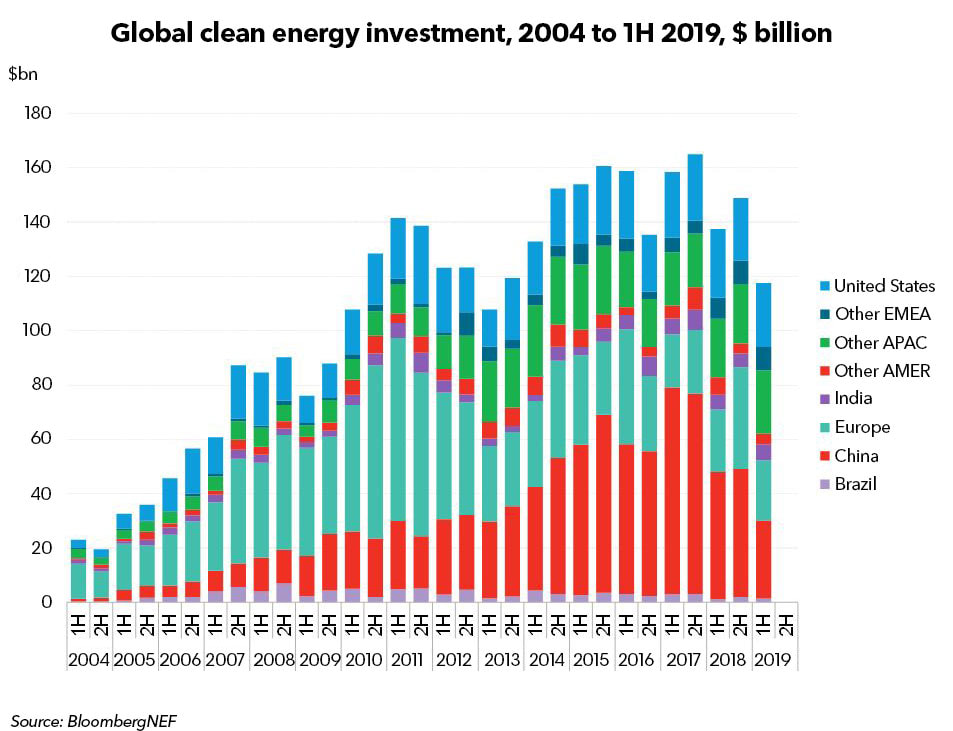|
This year has seen a considerable upping of the efforts of the scientific community and climate activists to raise the level of concern about the increased evidence for global warming and its severe consequences if nothing is done. Politicians in many jurisdictions have responded with promises for 100% renewable energy by 2030 to 2050 and US activists are touting a “clean new deal”. Unfortunately scientists, politicians and climate activists raising the alarm and promises of 100% renewables are only words.
The deed that shows us that actual progress is being made is the level of investment in clean energy. Unfortunately, as I have covered on this blog for many years, clean energy investment has been stalled since 2011. The latest data from Bloomberg new energy finance (BNEF) for the first half of 2019 shows a significant $18B decline over the same six month period in 2018, mostly due to China, but with declines in Europe, and the USA as well. The graph above illustrates the trend with the latest 2019 BNEF data. Without two unusual very big deals worth a total $10B, one in Kuwait, and the other in Taiwan, investment would have been even lower. BNEF expects some rebound in China in the second half of 2019 as their new policy regime based on auctions starts to take effect. However, the reason for the new policy regime is to bring a level of control to the market and stop the previous unsustainable unconstrained growth. China’s growth has been the engine that sustained overall investment since 2011 as European investment declined and US investment stayed relatively constant. As the graph shows,Chinese investment fell in 2018 and has reduced dramatically by 39% in the first half of 2019. China is no longer the growth driver. Going forward, the big markets in China, Europe, Japan and the US seem to be in overall decline. There is sporadic growth in the rest of the world, but insufficient to add significant growth overall. Its hard to see where the engine of future growth will come from. Growth so far has come from government support via various subsidy regimes. Worldwide these regimes have been scaled back in market after market since 2011 and as a result growth has stalled. If clean energy could compete without government support it would be growing. Despite the optimism of clean energy advocates its clear from the investment data that clean energy cannot compete in the real world. Advocates focus only on the cost of generation in the most optimistic of circumstances. The cost to the energy consumer includes all costs including the extra costs imposed as the system as a whole adapts to increased renewable generation. These increased costs are ignored by climate advocates who regard pointing out these costs as politically motivated to kill renewables. These costs start with curtailment costs for existing generation, additional transmission infrastructure costs and then renewable curtailment costs as renewables get to 15% or more. To satisfy higher renewable penetration daily storage is necessary adding significant additional cost (at least 2X). Existing fossil fuel generation cannot be retired as it is needed for the 20% of time that renewables plus storage cannot meet demand so its cost grows as it is increasingly curtailed. Eventually some long term storage probably based on fuel synthesis can replace the 20% fossil fuel energy remaining but this synthesis/generation cost is significantly higher than the fossil fuel generation capacity it replaces. Stratosolar has no long term intermittency so as it is added, fossil fuel generation can be eliminated. It has a cheap storage and cheap generation so its overall cost as more is deployed is vastly less than today's solar will cost, even with cost reductions and is also significantly lower than fossil fuel generation. The cost advantage of StratoSolar over regular solar at high penetration may be 10X. This sound exaggerated but the overall costs beyond simple generation are very significant. There is no other proposed electricity generation technology that can offer the possibility of clean energy at reduced cost over fossil fuels. This includes nuclear which has significant political issues as well. By Edmund Kelly
Comments
|
Archives
December 2023
Categories
All
|
|
© 2024 StratoSolar Inc. All rights reserved.
|
Contact Us
|


 RSS Feed
RSS Feed